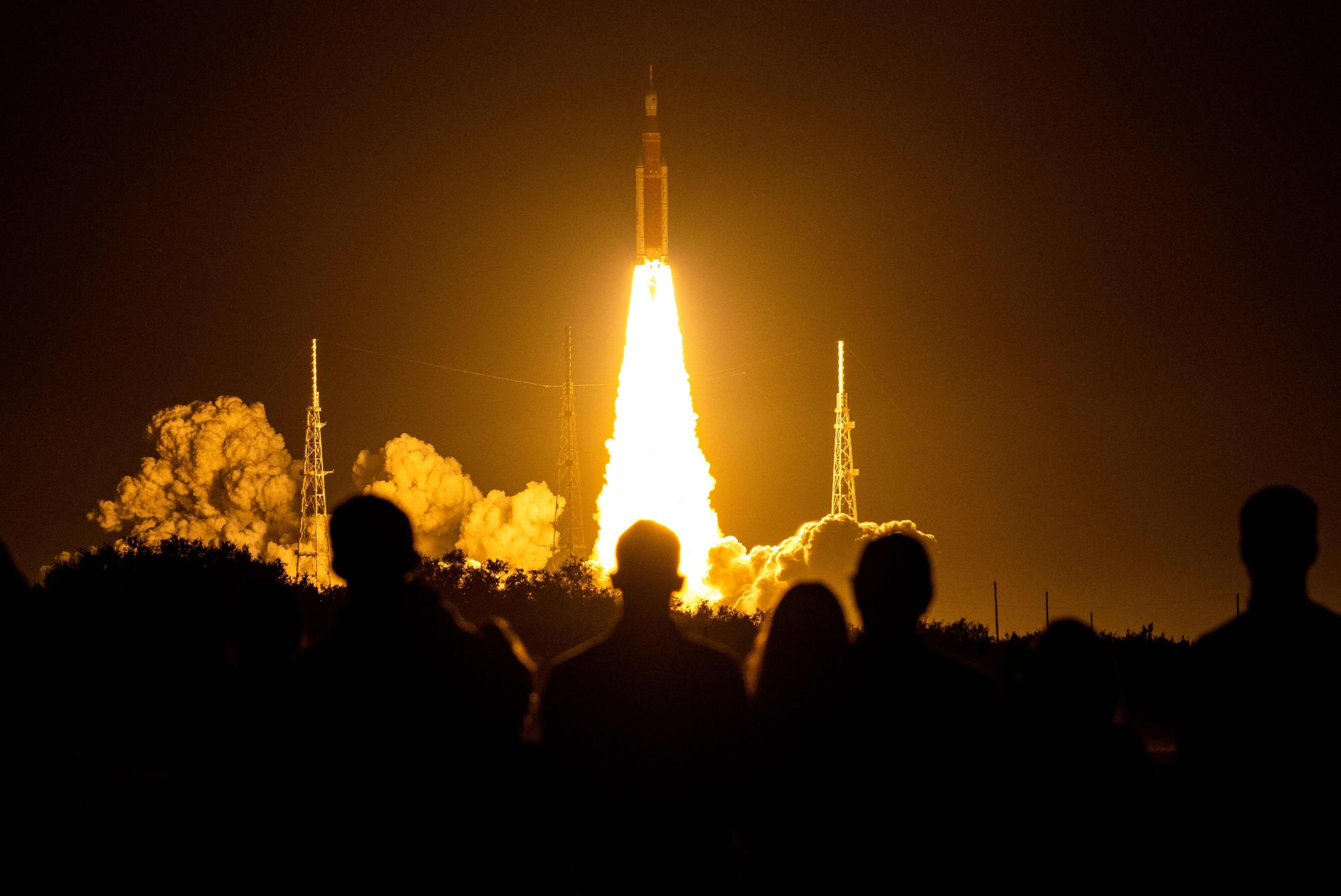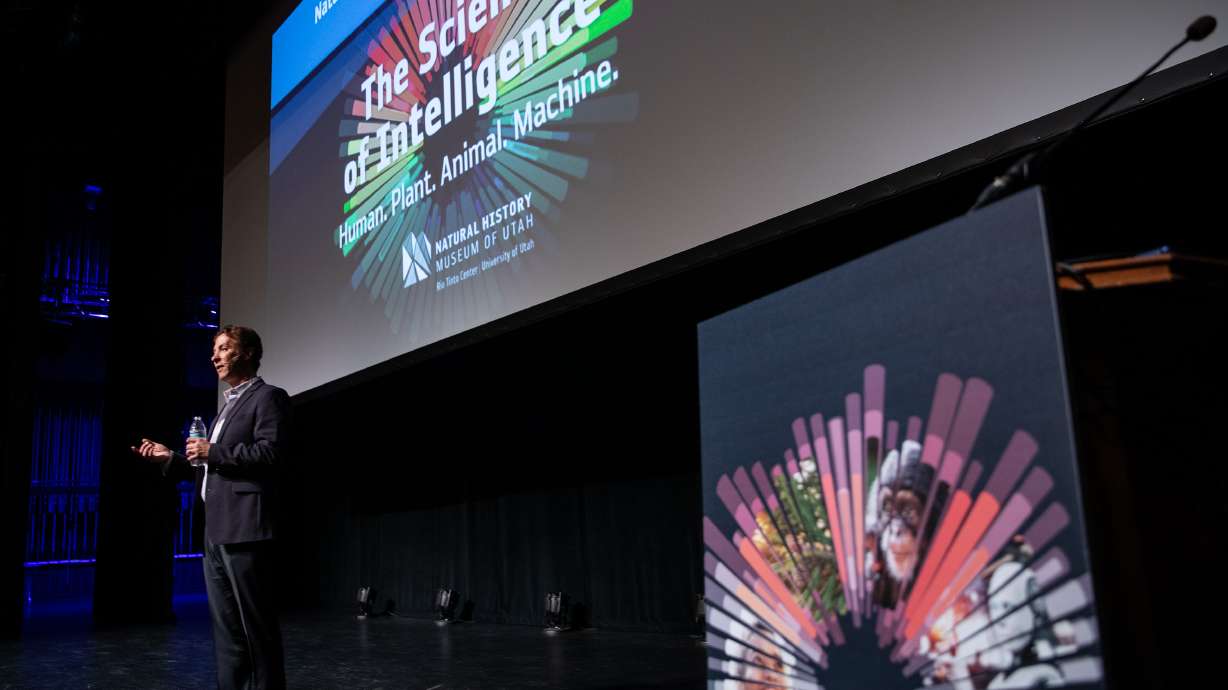2022’s extraordinary cosmic revelations and moments in space exploration
Dec 27, 2022, 9:55 AM

FILE: Spectators watch as the Artemis I uncrewed lunar rocket lifts off at NASA's Kennedy Space Center in Cape Canaveral, Florida, on November 16. The first piece of the solid rocket boosters that will propel NASA’s Artemis campaign to the moon, and eventually to Mars, is complete. It was built at Northrup Grumman’s facility in Promontory, Utah.(Jim Watson /AFP/Getty Images)
(Jim Watson /AFP/Getty Images)
(CNN) — This year, humankind glimpsed the universe in ways that were never before possible, and space missions took unprecedented leaps forward in unraveling the mysteries of the cosmos.
We witnessed the first mission to the International Space Station funded entirely by space tourists. A new space-based internet service played a key role in the war in Ukraine. And there were historic launches of spacecraft and technology by NASA and its international partners that could one day be used to land humans on Mars.
“There is no doubt that 2022 was out of this world,” NASA Administrator Bill Nelson said in a statement. “2022 will go down in the history books as one of the most accomplished years across all of NASA’s missions.”
Here are some of the unforgettable space discoveries and moments from 2022.
Artemis I moon mission launches
After years of preparation, NASA finally got its latest lunar exploration program off the ground with an uncrewed test flight that carried anastronaut-worthy spacecraft around the moon.
The mission was chock-full of huge moments. The rocket that got the mission off the ground, the Space Launch System or SLS, became the most powerful rocket ever to reach orbit — boasting 15% more thrust than the Saturn V rockets behind the Apollo program.
Upon reaching space, the Orion capsule, which flew empty save for a few test mannequins, captured stunning images of the Earth and moon. And Orion’s orbital path swung farther out beyond the far side of the moon than any spacecraft designed to carry humans has traveled before.
The trial run has paved the way for future Artemis missions, with the aim of returning humans to the lunar surface before mapping out a pathway for the first human spaceflight to Mars.
Webb telescope reveals the invisible universe
In partnership with international space agencies, NASA not only made strides in its human exploration program, but it also notched steps forward in scientific endeavors. After decades of anticipation, the James Webb Space Telescope finally began observing the universe in July.
Since then, the world’s most powerful space observatory has turned its gaze on planets, stars and galaxies in infrared light, which is invisible to the human eye.
The telescope has spied unseen aspects of the universe and previously hidden features, including the most distant galaxies ever observed. Webb has also shared new perspectives on some of astronomy’s favorite cosmic features and captured them in a new light, such as the Pillars of Creation.
The telescope’s images have already gone beyond what astronomers expected — and the best news: Webb is just getting started.
Observing astronomical wonders for the first time
The Webb telescope, however, wasn’t the only space observatory expanding our understanding of deep space. The Hubble Space Telescope spied the most distant single star ever observed, faintly shining 28 billion light-years away. The star existed just 900 million years after the big bang created the universe, and its light has traveled nearly 13 billion years to reach Earth.
Astronomers nicknamed the star Earendel, derived from an Old English word that means “morning star” or “rising light.”
Meanwhile, astronomers used the Event Horizon Telescope to capture an image of the supermassive black hole at the center of our galaxy for the first time. This first direct observation confirmed the presence of the black hole, known as Sagittarius A*, as the beating heart of the Milky Way.
While black holes don’t emit light, the shadow of the cosmic object was surrounded by a bright ring — light bent by the gravity of the black hole.
Shifting an asteroid’s trajectory in space
In late September, NASA successfully completed the first test mission for planetary defense. The space agency slammed a spacecraft into Dimorphos, a small asteroid that orbits a larger space rock named Didymos — and yes, the collision was intentional. The Double Asteroid Redirection Test, or DART, was a full-scale demonstration of deflection technology.
Neither Dimorphos nor Didymos poses a threat to Earth, but the system was a perfect target to test a technique that may one day be used to protect the planet from an asteroid strike.
The DART mission marked the first time humanity intentionally changed the motion of a celestial object in space. The spacecraft altered the moonlet asteroid’s orbit by 32 minutes.
NASA announces plans to study UFOs
And that’s not all 2022 offered when it came to the study of unusual objects in the skies. In June, NASA announced it would delve into the mysteries surrounding unidentified aerial phenomena, more popularly known as unidentified flying objects or UFOs. The space agency later selected a team of experts across numerous disciplines — including astrobiology, data science, oceanography, genetics, policy and planetary science — for the task.
Officials at NASA aren’t suggesting aliens may be responsible for such phenomena. The goal is merely to take a serious look at the as-yet-unexplained — but much publicly debated — topic of UAPs and how they might be studied through a scientific lens.
“Without access to an extensive set of data, it is nearly impossible to verify or explain any observation, thus the focus of the study is to inform NASA what possible data could be collected in the future to scientifically discern the nature of UAP,” according to a NASA news release.
Milestones on Mars
Meanwhile on the red planet, the InSight lander’s mission came to an end due to a surplus of dust on its solar panels (and no whirlwinds to vacuum them clean), but the stationary spacecraft made history in 2022. InSight detected the largest quake on Mars and captured the sounds of space rocks slamming into the planet — which created craters that revealed treasure troves of subsurface ice.
As InSight winds down, the Perseverance rover’s sidekick has continued to take to the Martian skies, above and beyond its original five-flight mission. The Ingenuity helicopter broke its own altitude record and has aced 37 flights on the red planet since April 2021. The little chopper has acted as an aerial scout for Perseverance, which collected an incredible diversity of Martian rock and sediment samples.
Now, the rover is setting up a depot of samples that will be stored on the Martian surface. The samples will be retrieved and returned to Earth in 2033 via the ambitious Mars Sample Return program, which will send a lander and a duo of retrieval helicopters to the red planet later this decade.
Interstellar meteor visits our cosmic neighborhood
Speaking of space rocks, a rare specimen traveled to Earth in 2014. But scientists just put its puzzle pieces together this year, and the discovery was announced in a US Space Command document.
The first known interstellar meteor to hit Earth crash-landed along the northeast coast of Papua New Guinea in January 2014.
Interstellar meteors are space rocks originating from outside our solar system, such as ʻOumuamua, the first known interstellar object in our solar system that was detected in 2017.
Debris from Space Shuttle Challenger disaster discovered
To be sure, NASA has seen many successes this year but also faced reminders of tragedy and disaster. Investigators set off in March to search suspected shipwreck sites in the Bermuda Triangle, a swath of the northern Atlantic Ocean said to be the site of dozens of shipwrecks and plane crashes, for a TV docuseries. But the crew stumbled upon something unexpected at another site off Florida’s east coast: a 20-foot-long (6-meter-long) piece of debris from the Space Shuttle Challenger, which broke apart shortly after takeoff in 1986 and killed all seven crew members aboard.
It was the first debris to be discovered since pieces from the shuttle washed ashore in 1996.
“This discovery gives us an opportunity to pause once again, to uplift the legacies of the seven pioneers we lost, and to reflect on how this tragedy changed us,” Nelson, the NASA administrator, said in a statement. “At NASA, the core value of safety is — and must forever remain — our top priority, especially as our missions explore more of the cosmos than ever before.”
Nascent satellite system provides internet to war-torn Ukraine
As Russia launched its invasion in February and some areas of Ukraine lost internet access, a space-based internet system that barely existed a few years ago began to provide crucial connectivity.
Elon Musk’s SpaceX designed and launched the system, called Starlink. It makes use of thousands of small satellites orbiting a few hundred miles above Earth. The satellites work in tandem to blanket the globe in internet connectivity, and all that’s needed to get online is an easy-to-use Starlink satellite dish.
Musk and SpaceX sent thousands of those dishes to Ukraine. Though a funding controversy later ensued, the use of Starlink in the Eastern European country was hailed as a game changer in strategic communication for its military, allowing Ukraine to fight effectively, even as the ongoing war disrupted cellular phone and internet networks.
First all-private mission to the space station
Starlink, however, is one small part of SpaceX’s booming business. The company routinely launches not only satellites but also astronauts into space on NASA’s behalf. And this year, SpaceX even flew a few wealthy thrill-seekers to the International Space Station on a mission brokered by Axiom. The event marked the first space station mission that was fully paid for by paying customers and included only private citizens.
There were four crew members. Michael López-Alegría, a former NASA astronaut-turned-Axiom employee, was mission commander. And the three paying customers were Israeli businessman Eytan Stibbe, Canadian investor Mark Pathy and Ohio-based real estate magnate Larry Connor.
The mission, called AX-1, launched on April 8 and was originally billed as a 10-day trip. Delays, however, extended the mission by about a week.
Allowing private missions to the space station is part of NASA’s plan for more commercial activity in low-Earth orbit as it turns its focus to exploring deep space.
Related: Utah State University helps NASA with space exploration













